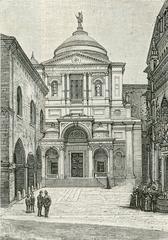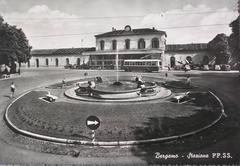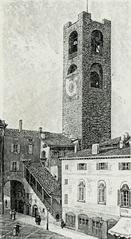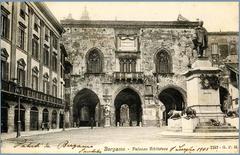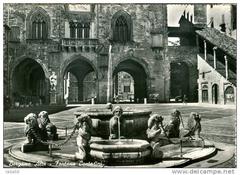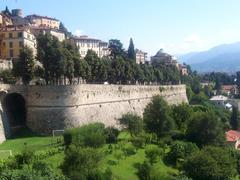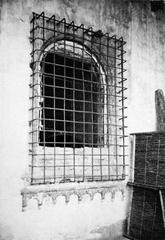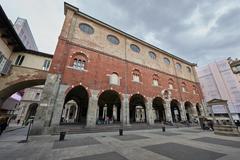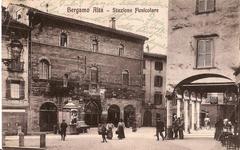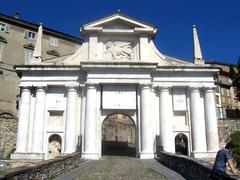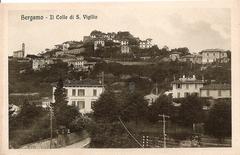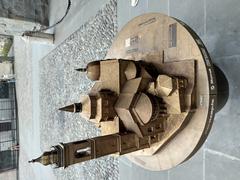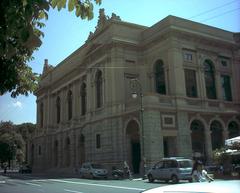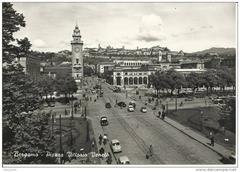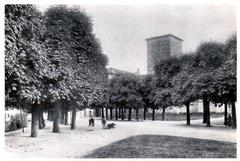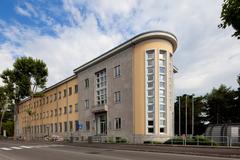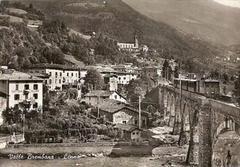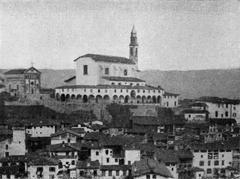Visiting Parco Regionale dei Colli di Bergamo: Tickets, Hours, and Tips
Publication Date: 01/08/2024
Introduction
Nestled in the heart of Lombardy, Italy, the Parco Regionale dei Colli di Bergamo is an alluring destination for nature lovers and cultural enthusiasts alike. Established in 1977, this regional park spans approximately 5,000 hectares, making it the third-largest park in Lombardy. Visitors to the park are treated to a unique blend of natural beauty and cultural heritage, with scenic trails, historic sites, and traditional agricultural events on offer (Parco dei Colli di Bergamo). The park’s rich history dates back to ancient times, with human settlements having shaped its landscape for centuries. The park’s diverse geography, from its highest peak at Canto Alto to its lowest point at 244 meters above sea level, adds to its captivating allure (Wikipedia). In this comprehensive guide, we will explore the parco’s history, geographical features, visitor information, and much more, offering valuable insights for planning your visit.
Table of Contents
- Introduction
- Establishment and Purpose
- Geographical and Geological Features
- Historical Human Settlement
- Monastic Influence
- Expansion and Conservation Efforts
- Biodiversity and Natural Significance
- Visitor Information
- Cultural and Recreational Importance
- Agricultural and Educational Initiatives
- Nearby Attractions
- FAQs
- Conclusion
Establishment and Purpose
The Parco Regionale dei Colli di Bergamo was officially established in 1977 with the primary goal of preserving and enhancing the delicate balance between nature and human presence in the region. Covering approximately 5,000 hectares, the park spans eleven municipalities, making it the third-largest park in Lombardy. The park’s creation was driven by the need to protect the unique environmental and cultural heritage of the area, which includes both natural landscapes and urban spaces of significant artistic and architectural value (Parco dei Colli di Bergamo).
Geographical and Geological Features
The park is situated in the province of Bergamo, Lombardy, in northern Italy. It encompasses a diverse range of terrains, from the plains to the hills and mountains. The highest point in the park is Canto Alto, which stands at 1,144 meters above sea level, while the lowest point is at 244 meters. The park is also traversed by the Morla and Quisa rivers, adding to its rich natural diversity (Wikipedia).
Geologically, the park belongs to the Southern Alps and features sedimentary rocks dating back to the Triassic period, approximately 200 to 70 million years ago. Notable rock formations include the Calcare di Sedrina, Calcare di Moltrasio, and Calcare marnoso di Domaro. Additionally, quaternary deposits such as lacustrine clays and sands are found in areas like Almè and Petosino (Wikipedia).
Historical Human Settlement
The hills of Bergamo have been hospitable to human settlement since ancient times, particularly along the gentle southern slopes. This long history of human activity has resulted in a landscape that is both varied and rich in cultural heritage. The park includes historic villages, vineyards, chestnut woods, and olive groves, all of which have been shaped by centuries of human cultivation and settlement (Visit Bergamo).
Monastic Influence
One of the most significant historical aspects of the park is its association with monastic communities. The Vallumbrosan monks and Benedictine nuns settled in the Astino and Valmarina valleys, respectively, following the Benedictine rule of “ora et labora” (pray and work). The Valmarina monastery, now the main office of the park, continues to be a lively cultural center, while the Astino monastery hosts various events and has been revitalized through organic farming initiatives (Visit Bergamo).
Expansion and Conservation Efforts
In 2023, the park underwent a significant expansion, incorporating the PLIS ‘Parco Agricolo Ecologico Madonna dei Campi’ in the Grumello del Piano and Colognola districts. This addition contributed 257 hectares to the park, creating a green belt to the south of Bergamo and protecting an area that had remained undeveloped despite the surrounding urbanization. Further expansions included 7 hectares in the municipalities of Valbrembo and Ranica, and 31 hectares in Berbenno, bringing the total area of the park to 343 hectares (Wikipedia).
Biodiversity and Natural Significance
The park is a haven for a wide variety of flora and fauna. The majority of the park’s area is covered by woods, which provide a habitat for numerous species. Notable wildlife includes foxes, European badgers, and the European robin, which is the most widespread bird in the park. The park also serves as a crucial nesting site for birds of prey and is home to the rare yellow-bellied toad (Bombina variegata) (Wikipedia).
Visitor Information
Visiting Hours and Tickets
The Parco Regionale dei Colli di Bergamo is open year-round, but specific attractions within the park may have varying visiting hours. It is advisable to check the official website or contact the park administration for the most up-to-date information on visiting hours and ticket prices. Some areas of the park may require an entrance fee, particularly during special events or exhibitions. For detailed information, visit the official website.
Travel Tips and Accessibility
The park is accessible by car, public transportation, and even on foot for those who enjoy hiking. Several parking areas are available near major entrances. Visitors are encouraged to wear comfortable walking shoes and bring water, especially during warmer months. The park is also equipped with facilities for visitors with disabilities, ensuring that everyone can enjoy its beauty.
Cultural and Recreational Importance
The Parco dei Colli di Bergamo is not only a natural sanctuary but also a cultural and recreational hub. Visitors can explore historic sites such as the San Vigilio Castle, which offers panoramic views of the surrounding landscape. The park also features numerous trails, agricultural areas, and beautiful architectural landmarks, including the birthplace of the composer Donizetti and the Church of Santa Grata Inter Vites (Visit Bergamo).
Agricultural and Educational Initiatives
The park actively promotes the preservation and appreciation of local agricultural products through various initiatives and events, such as the Festival del Pastoralismo and the Mercato Agricolo di Valmarina. These events highlight the park’s role in sustaining traditional farming practices and educating the public about the region’s agricultural heritage (official website).
Nearby Attractions
While visiting the Parco Regionale dei Colli di Bergamo, consider exploring nearby attractions such as the Città Alta (Upper Town) of Bergamo, known for its medieval architecture and vibrant cultural scene. Other notable sites include the Accademia Carrara, a renowned art gallery, and the Orto Botanico di Bergamo “Lorenzo Rota,” a botanical garden that showcases a variety of plant species.
FAQs
What are the visiting hours for Parco Regionale dei Colli di Bergamo?
The park is open year-round, but specific attractions may have varying visiting hours. Check the official website for the latest information.
How much do tickets cost?
Ticket prices vary depending on the attraction and event. It is best to check the official website or contact the park administration for detailed information.
What are some travel tips for visiting the park?
Wear comfortable walking shoes, bring water, and be prepared for varying weather conditions. The park is accessible by car, public transportation, and on foot.
Are there facilities for visitors with disabilities?
Yes, the park is equipped with facilities to ensure accessibility for all visitors.
What are some nearby attractions?
Nearby attractions include the Città Alta, Accademia Carrara, and Orto Botanico di Bergamo “Lorenzo Rota.”
Conclusion
The Parco Regionale dei Colli di Bergamo stands as a testament to the harmonious coexistence of nature and human activity. Its establishment in 1977 marked a significant effort to preserve the region’s unique environmental and cultural heritage. Today, the park offers a rich tapestry of natural beauty and historical significance, making it a must-visit destination for nature lovers and cultural enthusiasts alike. From its diverse landscapes and abundant wildlife to its historical monasteries and agricultural festivals, the park provides a unique blend of experiences that cater to a wide range of interests. Whether you’re exploring its scenic trails, participating in its cultural events, or simply enjoying the serene beauty of its natural surroundings, a visit to Parco Regionale dei Colli di Bergamo promises a memorable and enriching experience (Parco dei Colli di Bergamo).
References
- Parco dei Colli di Bergamo, 2023, https://www.icollidibergamo.it/parco-dei-colli-di-bergamo/
- Parco dei Colli di Bergamo, 2023, https://en.wikipedia.org/wiki/Parco_dei_Colli_di_Bergamo
- Parco dei Colli di Bergamo, 2023, https://blog.visitbergamo.net/en/bergamos-parco-dei-colli/
- Parco dei Colli di Bergamo, 2023, https://it.wikipedia.org/wiki/Parco_dei_Colli_di_Bergamo
- Parco dei Colli di Bergamo, 2023, https://www.visitbergamo.net/en/object-details/7368-parco-dei-colli/
- Parco dei Colli di Bergamo, 2023, https://www.parcocollibergamo.it/ITA/Home.asp
